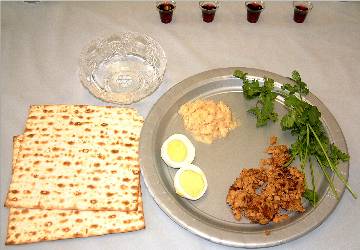I love any time I get to use food in a traditional and historical way. It has been celebrated yearly from the time in Exodus. The meaning of Seder Meal is "order", telling the story of the Hebrews slavery in Egypt and deliverance. It is not just practiced by the Jews but those wishing to become closer to the scripture and history of this meal. We like to do a basic Seder Meal on Holy Thursday for the purpose of recreating the event the Hebrews experienced. It is a great time to talk about slavery, faith, and trust in God. Start to finish it symbolizes a time of pain and ends in praise of deliverance. It helps kids bring the story of Exodus to life. Jesus came to Jerusalem on Palm Sunday to partake in the Passover and share this meal with his disciples before his Passion took place. Here the use of food is a direct representation of life experiences. This is a wonderful experience!
What is used during a Seder
Lamb- the word "pesach" (passover) applies to the Lamb of sacrifice and the deliverance from Egypt. Roasted and seasoned with garlic, onion, and herbs.
Unleavened bread- Matzoh is called the "bread of Affliction" because it recalls the unleavened bread they prepared for a hasten escape by night from Egypt. Three large matzohs are broken and eaten during the ceremony.
Bitter herbs- (Horseradish) is a reminder of the bitterness of slavery and suffering endured in Egypt.
Green herbs- (Parsley and Celery) to be dipped in salt water. The salt water represents tears of sorrow during the captivity of the Lord's people.
Haroseth- is a mixture of chopped apples, nuts, cinnamon, and wine representing the mortar used by the Jews to build structures in Egypt during their slavery.
Wine- (Red) used to sip on with four words through the meal. "The four cups", Thanksgiving, Telling, Blessing, and Righteousness.
You can make your own Unleavened Bread.
- 1 cup whole wheat flour
- 3 tbsp oil
- pinch of salt
- just enough water to make a dough, non sticky
For a Seder Meal outline see Introduction to a Christian Seder. They do a wonderful job of mapping out a passover with description, pictures, and history. This meal should and can be a great history lessen for the whole family. It does not have to be the exact interpretation. Have fun with the kids and teach them some tradition, culture, and faith.

I am going to try the unleavened bread today. Thanks for sharing this. I learned a lot from it.
ReplyDeleteDanielle
I hope you enjoyed the recipe! Thanks for stopping by.
DeleteI've been to several Seder meals and they are always fun. Never thought of making my own though.
ReplyDeleteWe making it lots of fun for the kids so its a nice educational experience. Thanks for stopping by!
DeleteWe celebrated Passover with a Seder last year, but with as crazy as it has been this year with the new baby and then having to be in the hospital when he was sick, I didn't think about it soon enough to get it ready this year. Thank you so much for instructions on making the unleavened bread. I couldn't really find anything that was appropriate last year. Forget what I ended up using.
ReplyDeleteI am now following you. Would love a follow back at Tots and Me
I am glad you can use the recipe next year. We actually liked the bread for a flat bread recipe as well. Thank you for the follow, I ma following back :-)
DeleteThanks for sharing this with us, very nice lesson.
ReplyDeleteThanks for sharing this!
ReplyDeleteI participated in my first Passover meal last week with my church's small group! It was a very interesting experience, but it was nice to experience something traditional when the a lot of Christian faith has looked down on traditions! I hope to do it again next year and maybe appreciate it a little bit more!
ReplyDelete